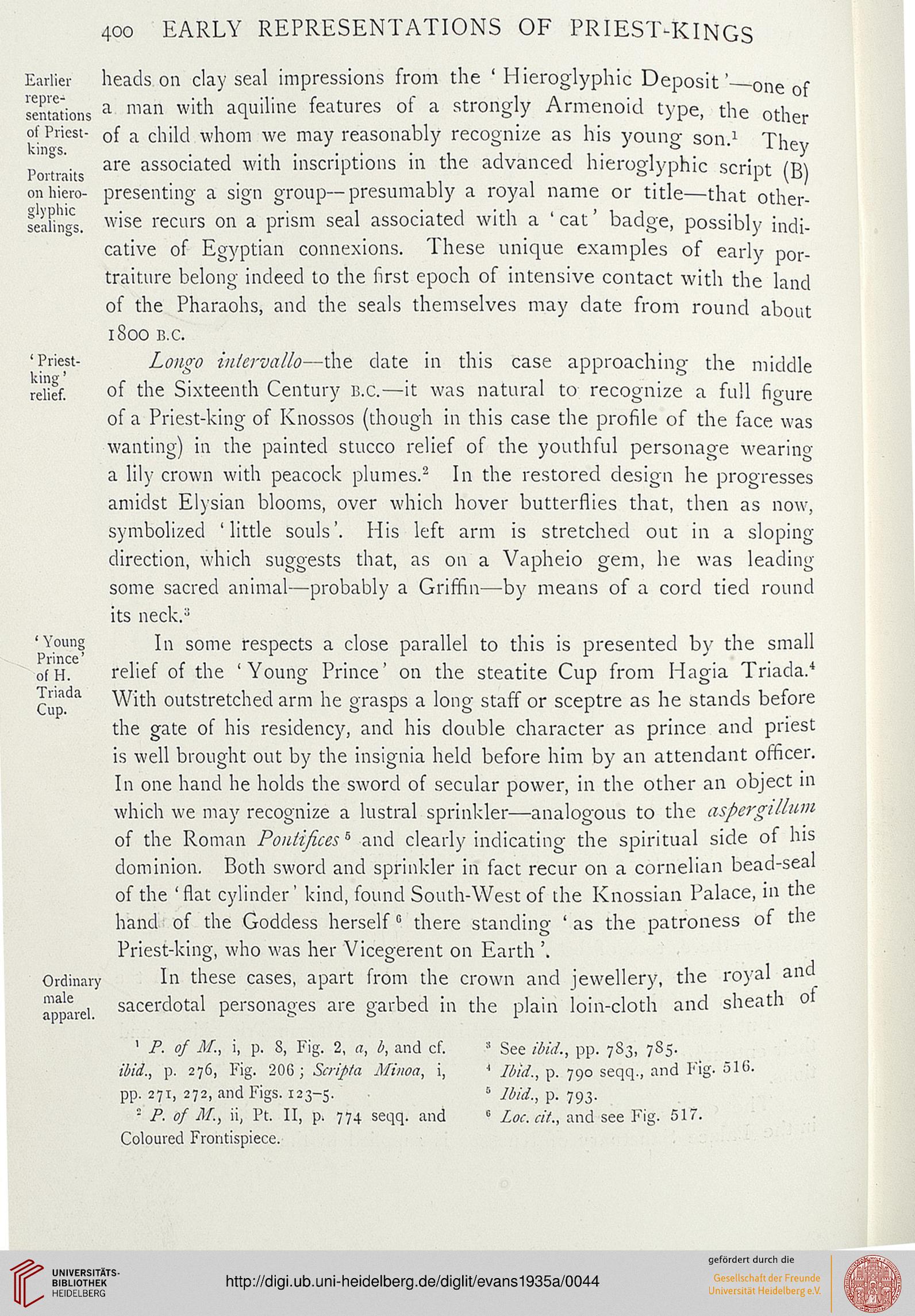4oo EARLY REPRESENTATIONS OF PRIEST-KINGS
Earlier heads on clay seal impressions from the ' Hieroglyphic Deposit'__one of
situations a man with aquiline features of a strongly Armenoid type, the other
of Priest- 0f a chilci whom we may reasonably recognize as his young- son.i -pjle
'. are associated with inscriptions in the advanced hieroglyphic script IK\
onhiero- presenting a sign group—presumably a royal name or title—that other-
seafings. w'se recurs on a prism seal associated with a 'cat' badge, possibly indi-
cative of Egyptian connexions. These unique examples of early por-
traiture belong indeed to the first epoch of intensive contact with the land
of the Pharaohs, and the seals themselves may date from round about
1800 B.C.
'Priest- Longo intervallo—the date in this case approaching the middle
relief. of the Sixteenth Century B.C.—it was natural to recognize a full fio-ure
of a Priest-king of Knossos (though in this case the profile of the face was
wanting) in the painted stucco relief of the youthful personao-e wearino
a lily crown with peacock plumes.2 In the restored design he progresses
amidst Elysian blooms, over which hover butterflies that, then as now,
symbolized 'little souls'. Mis left arm is stretched out in a sloping-
direction, which suggests that, as on a Vapheio gem, he was leading-
some sacred animal—probably a Griffin—by means of a cord tied round
its neck."
'Young In some respects a close parallel to this is presented by the small
ofH. relief of the 'Young Prince' on the steatite Cup from Hagia Triada.*
c!ipda With outstretched arm he grasps a long staff or sceptre as he stands before
the gate of his residency, and his double character as prince and priest
is well brought out by the insignia held before him by an attendant officer.
In one hand he holds the sword of secular power, in the other an object in
which we may recognize a lustral sprinkler—analogous to the aspergillum
of the Roman Pontifices6 and clearly indicating the spiritual side of his
dominion. Both sword and sprinkler in fact recur on a cornelian bead-seal
of the ' flat cylinder' kind, found South-West of the Knossian Palace, in the
hand of the Goddess herself 8 there standing- ' as the patroness of the
Priest-king, who was her Vicegerent on Earth '.
Ordinary In these cases, apart from the crown and jewellery, the royal and
imjarel sacerdotal personages are garbed in the plain loin-cloth and sheath 01
apparel.
1 P. of M., i, p. S, Fig. 2, a, b, and cf. ! See ibid., pp. 783, 785.
ibid., p. 276, Fig. 206 ; Scripta Minoa, i, ■' Ibid., p. 790 seqq., and Fi
pp. 271, 272, and Figs. 123-5. 5 Mi., p. 793.
; P. of M., ii, Ft. II, p. 774 seqq. and s Local., and see Fig. 517.
Coloured Frontispiece.
Earlier heads on clay seal impressions from the ' Hieroglyphic Deposit'__one of
situations a man with aquiline features of a strongly Armenoid type, the other
of Priest- 0f a chilci whom we may reasonably recognize as his young- son.i -pjle
'. are associated with inscriptions in the advanced hieroglyphic script IK\
onhiero- presenting a sign group—presumably a royal name or title—that other-
seafings. w'se recurs on a prism seal associated with a 'cat' badge, possibly indi-
cative of Egyptian connexions. These unique examples of early por-
traiture belong indeed to the first epoch of intensive contact with the land
of the Pharaohs, and the seals themselves may date from round about
1800 B.C.
'Priest- Longo intervallo—the date in this case approaching the middle
relief. of the Sixteenth Century B.C.—it was natural to recognize a full fio-ure
of a Priest-king of Knossos (though in this case the profile of the face was
wanting) in the painted stucco relief of the youthful personao-e wearino
a lily crown with peacock plumes.2 In the restored design he progresses
amidst Elysian blooms, over which hover butterflies that, then as now,
symbolized 'little souls'. Mis left arm is stretched out in a sloping-
direction, which suggests that, as on a Vapheio gem, he was leading-
some sacred animal—probably a Griffin—by means of a cord tied round
its neck."
'Young In some respects a close parallel to this is presented by the small
ofH. relief of the 'Young Prince' on the steatite Cup from Hagia Triada.*
c!ipda With outstretched arm he grasps a long staff or sceptre as he stands before
the gate of his residency, and his double character as prince and priest
is well brought out by the insignia held before him by an attendant officer.
In one hand he holds the sword of secular power, in the other an object in
which we may recognize a lustral sprinkler—analogous to the aspergillum
of the Roman Pontifices6 and clearly indicating the spiritual side of his
dominion. Both sword and sprinkler in fact recur on a cornelian bead-seal
of the ' flat cylinder' kind, found South-West of the Knossian Palace, in the
hand of the Goddess herself 8 there standing- ' as the patroness of the
Priest-king, who was her Vicegerent on Earth '.
Ordinary In these cases, apart from the crown and jewellery, the royal and
imjarel sacerdotal personages are garbed in the plain loin-cloth and sheath 01
apparel.
1 P. of M., i, p. S, Fig. 2, a, b, and cf. ! See ibid., pp. 783, 785.
ibid., p. 276, Fig. 206 ; Scripta Minoa, i, ■' Ibid., p. 790 seqq., and Fi
pp. 271, 272, and Figs. 123-5. 5 Mi., p. 793.
; P. of M., ii, Ft. II, p. 774 seqq. and s Local., and see Fig. 517.
Coloured Frontispiece.





